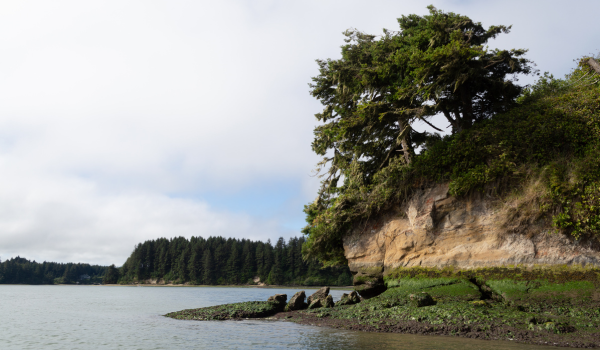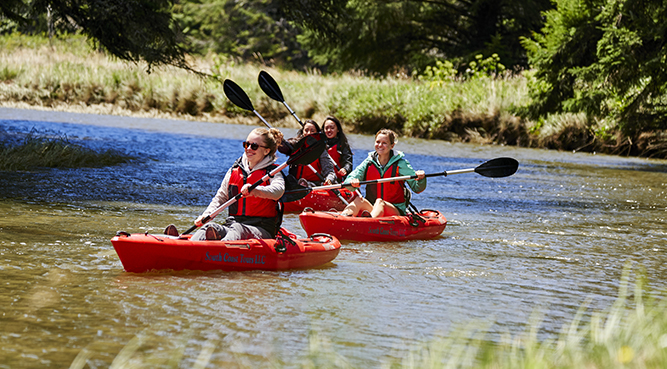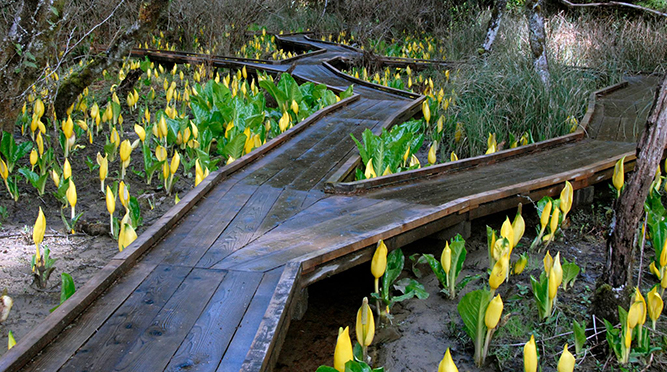Why We Should Care About Estuaries Like South Slough National Estuarine Research Reserve

Did you know? One of the richest ecosystems and most bio-diverse destinations on the Oregon Coast is right in our own backyard? The South Slough National Estuarine Research Reserve (SSNERR) is among the most precious natural habitats on the Oregon coast. You’ve heard us say that Oregon’s Adventure Coast: Coos Bay, North Bend, Charleston is where the land meets the bay and the sea; estuaries like SSNERR are where rivers meet the sea.
In general, many people do not know the impact that estuaries have on our ecosystem and daily lives until they visit one. Estuaries such as the South Slough are vital to our way of life for the following reasons:
-
They help to mitigate the devastating impacts of flooding by acting as a natural barrier against storms, while also absorbing and storing carbon.
-
They provide essential habitats for both commercial and recreational fisheries.
-
They enhance water quality by effectively filtering out sediment and pollutants.
-
They are nurturing grounds for a diverse array of species, including various fish, shellfish, and invertebrates. Basically, South Slough is a nursery for our dungeness crab, salmon, herring, oystersand other fish species!

In honor of National Estuaries Week (September 16-23, 2023), here are some fun facts about estuaries and South Slough National Estuarine Research Reserve (SSNERR).
#1- Much of the South Slough Reserve’s 5,900-acres is forested but it also encompasses a healthy variety of protected wetlands, riparian areas, and open water habitats.
#2- South Slough has a rich history of habitation dating back thousands of years when the Miluk people established their presence in the region. Echoes of their civilization, such as fishing traps, still endure, serving as reminders of their legacy. Notably, tribal members maintain an ongoing connection and involvement with the reserve, preserving the enduring bond between their community and this cherished land.
#3- Established in 1974, South Slough National Estuarine Research Reserve was the first of thirty U.S. coastal estuaries to join the National Estuarine Research Reserve System.
#4- It is managed by the Oregon Department of State Lands and the U.S. Department of Commerce’s National Oceanic and Atmospheric Administration.
#5- The reserve is a living laboratory where thousands of visitors, researchers, and students come each year to learn about marine science, coastal management, water quality, weather monitoring, climate change, species and habitat research and monitoring, as well as restoration and stewardship projects.
#6- The South Slough Interpretive Center offers visitors numerous learning opportunities and interpretive exhibits on coastal ecosystems, plants and animals, cultural history, and more. Visitors can also enjoy browsing through the bookstore and taking in spectacular views of the estuary and forest. The Visitor Center is open every Tuesday - Saturday, 10 a.m. - 4 p.m. with the exception of state holidays.
#7- Oregon’s estuaries like South Slough National Estuarine Research Reserve helps to sustain young Dungeness crab, salmon, herring, oysters and shellfish. They provide stopovers where migrating waterfowl can rest and find food.
#8- South Slough features well maintained trails and a boardwalk that winds through fresh and saltwater marshes, making it ideal for nature walks any time of the year.
#9- The estuary’s mudflats where millions of clams, shrimp and worms live just below its surface, are exposed at low tide, making them an ideal destination for birds and mammals to find food. Over time, the accumulation of silt has resulted in these mudflats that are hundreds of feet deep
#10- Wildlife abounds in estuaries like South Slough National Estuarine Research Reserve. Its forest is home to numerous small mammals, bats, elk, black bear, bobcats as well many species of birds, amphibians and reptiles. The forest streams support the salmon population as well as other native fish, oysters, crabs and beavers.
#11- The reserve includes open water channels, tidal and freshwater wetlands that visitors may access by kayak and canoe. Water Trails Kayaks and canoes can be launched at Hinch Bridge or in Charleston. A paddler’s brochure is available at the Interpretive Center. Click here for a schedule of their guided tours and other programs.
#12- The reserve is free for the public to visit; however, there are fees associated with some classes and activities.

South Slough NERR is more than a beautiful destination to hike and unwind; it is a living, breathing natural resource dedicated to sustaining the environment and coastal way of life. The reserve is located at 61907 Seven Devils Road Charleston, OR 97420. For more information, visit www.oregon.gov or call (541) 888-5558 for info.
Additional Resources
- About South Slough Reserve
- Brochure and trail map
- South Slough Paddle Map
- Paddling South Slough
- Coos Bay Estuary Water Trails
- Tides for Charleston, Oregon
- Birds of Coos County
- Programs and Events Calendar
- Wildlife at South Slough Reserve
- Event Registration
- National Estuarine Research Reserve Association (NERRA)
- Association of National Estuary Programs (ANEP)
There is an adventure for everyone on Oregon’s Adventure Coast: Coos Bay, North Bend, Charleston . Be sure to book your accommodations in Coos Bay, North Bend, Charleston early by clicking here . Whether you are on the hunt for awe-inspiring landscapes, thrilling outdoor activities, prime shopping, fine dining, special events, or an evening of entertainment, you will find it here. For more information, please contact the Coos Bay – North Bend Visitor & Convention Bureau .
